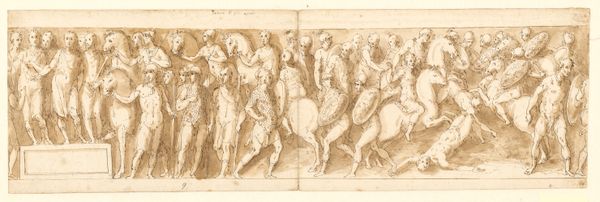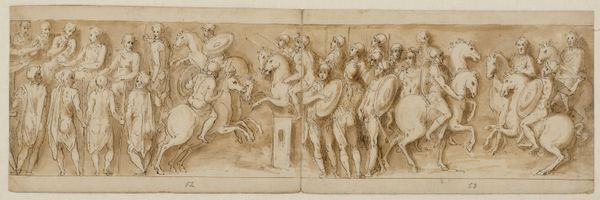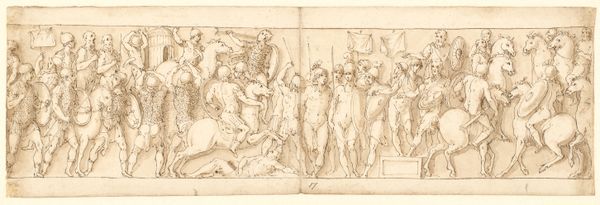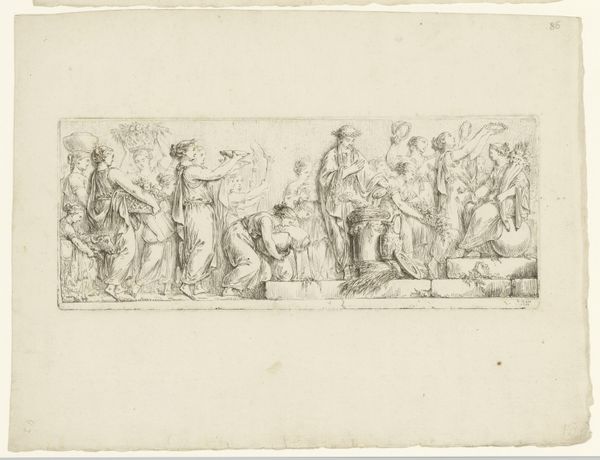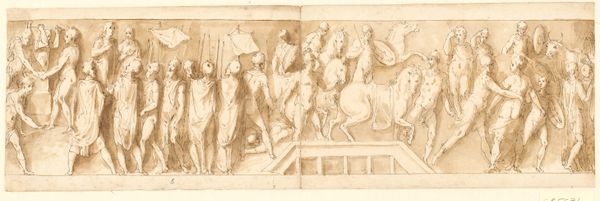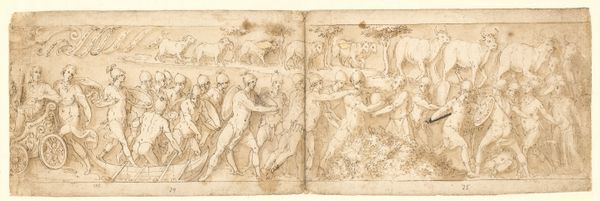
End of a march by the emperor with his legionaries and guards (end of XCIII); the Romans building a camp (beginning of XCIV); the Romans on a march with the emperor (XXXV / XXXVI) 1544 - 1618
0:00
0:00
drawing, paper, ink
#
drawing
#
toned paper
#
light pencil work
#
narrative-art
#
pen sketch
#
pencil sketch
#
classical-realism
#
etching
#
paper
#
romanesque
#
personal sketchbook
#
ink
#
pen-ink sketch
#
pen work
#
sketchbook drawing
#
history-painting
#
sketchbook art
Dimensions: 133 mm (height) x 432 mm (width) (bladmaal)
Curator: Giovanni Guerra, sometime between 1544 and 1618, captured this scene titled, "End of a march by the emperor with his legionaries and guards (end of XCIII); the Romans building a camp (beginning of XCIV); the Romans on a march with the emperor (XXXV / XXXVI)". It is currently held at the SMK, the National Gallery of Denmark. Editor: My initial impression is one of dynamic tension, an almost frieze-like composition depicting a triumphal march rendered in sepia tones with great energy, though seemingly unfinished. It really evokes a sense of classical antiquity and power. Curator: Indeed, the triumphal march, a visual trope of Roman power, is quite present. This drawing provides insight into the artist's method of capturing this historical theme. It showcases Guerra's creative process. Likely commissioned, works like these offer invaluable clues regarding artistic creation and the cultural expectations of his patrons. Editor: Look at the figure groupings, they feel deeply symbolic! The emperor and his legionaries, caught at various stages. I notice how Guerra uses linear perspective sparingly, emphasizing a psychological rather than literal space. There is definitely a story of symbolic progression and heroic narrative woven into the details here. Curator: Precisely! Considering this period, this work also provides a lens through which we might understand the visual rhetoric deployed during times of significant political and social change. Representations of power were crucial. How the marchers are portrayed and their relationship to their leader would tell us what it meant to serve during those times. Editor: Right, there is an obvious interest in depicting symbols of power through the careful placement of figures and the dynamics between the leader and the group. It suggests the complex relationship between power and unity of purpose as conveyed through visual symbol and action, such as through posture and proximity. The march becomes more than a march, doesn’t it? Curator: Yes. Artworks such as this, while appearing straightforward in their representation of historical events, served deeper socio-political purposes in constructing and reinforcing notions of empire. We must keep this purpose in mind to grasp its meaning for Guerra’s patrons. Editor: Knowing how potent these images were—then and now—allows us to see Giovanni Guerra’s sketch as a crucial visual text worthy of continuous analysis. Curator: A great reminder of the layers involved.
Comments
No comments
Be the first to comment and join the conversation on the ultimate creative platform.



